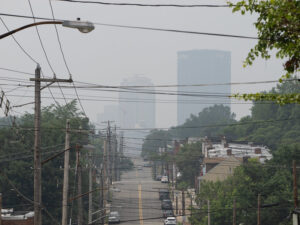
A view of Pittsburgh in the summer of 2023 during the Canadian Wildfires showing the poor air quality. Photo by documentary filmmaker and friend of GASP, Mark Dixon / Blue Lens.
GASP’s Guide to Understanding Local Air Quality
At Group Against Smog & Pollution (GASP), we believe that knowledge is power, and this quick, plain-language guide aims to give readers a broad overview of air pollution, how we’re affected, and how we can be more aware of conditions and protect ourselves.
What Types of Air Pollution Should I Be Concerned About?
While there are myriad types of air pollution, the U.S. Environmental Protection Agency (EPA) has set health-based standards for six: ground-level ozone, particulate matter, carbon monoxide, lead, sulfur dioxide, and nitrogen dioxide. Known as criteria pollutants, they are widespread and pose significant harm to both the environment and human health.
Then there are Hazardous Air Pollutants (HAPs), sometimes referred to as air toxics, which are pollutants known or suspected to cause cancer or other serious health effects such as birth defects.
Where Does Air Pollution Come From?
Air pollution comes primarily from three sources:
- Natural causes like wildfires and even volcanoes.
- Mobile sources like emissions from planes, trains, and automobiles (also: ships and construction equipment, among others).
- Stationary sources like steel mills, factories, compressor stations, and power plants. If you live in Southwestern Pennsylvania and want to learn more about the major stationary sources of air pollution in your neighborhood, check out GASP’s air quality permits clearinghouse.
How Can I Protect Myself From Air Pollution?
They say an ounce of preparation is worth a pound of cure, and the same is true when it comes to protecting yourself from poor air quality. That’s why it’s so important to be aware of what the air quality is like in your neighborhood.
You can stay in the know by checking out the AirNow.gov, an EPA website and app that tracks the Air Quality Index (AQI) throughout the country. The AQI gives you a forecast of what your local air will be like and what the associated health effects are.
The EPA describes AQI like this:
Think of the AQI as a yardstick that runs from 0 to 500. The higher the AQI value, the greater the level of air pollution and the greater the health concern. For example, an AQI value of 50 or below represents good air quality, while an AQI value over 300 represents hazardous air quality. … When AQI values are above 100, air quality is unhealthy: at first for certain sensitive groups of people, then for everyone as AQI values get higher.
The AQI is divided into six categories. In a color-coded range from green to purple, each category corresponds to a different level of health concern. The color makes it easy for people to quickly determine whether air quality is reaching unhealthy levels in their communities.
Once you understand what air quality is like in your neighborhood, you can pre-plan your outdoor activities to minimize your exposure to air pollution, especially if you or your family members belong to a “sensitive pollution.” People with heart or lung diseases, people with asthma, children, and older adults are a few of the populations considered more sensitive to poor air quality. And remember: opening your windows does not always mean fresher indoor air. Sometimes our windows are helping to keep the air pollution outside.
Group Against Smog and Pollution (GASP) is a 501 (c)(3) non-profit in Southwestern Pennsylvania working for a healthy, sustainable environment. Founded in 1969, GASP has been a diligent watchdog, educator, litigator, and policy-maker on many environmental issues, with a focus on air quality in the Pittsburgh region.
Find our full Plain-Language Guide to Understanding Local Air Quality here (for a Spanish version, see here) and additional blog posts here.
Air quality, air pollution, public health




